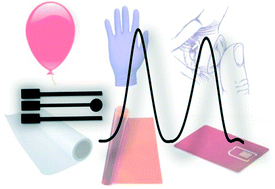Our official English website, www.x-mol.net, welcomes your
feedback! (Note: you will need to create a separate account there.)
Flexible plastic, paper and textile lab-on-a chip platforms for electrochemical biosensing
Lab on a Chip ( IF 6.1 ) Pub Date : 2018-05-26 00:00:00 , DOI: 10.1039/c8lc00025e Anastasios Economou 1, 2, 3, 4 , Christos Kokkinos 1, 2, 3, 4 , Mamas Prodromidis 1, 4, 5, 6
Lab on a Chip ( IF 6.1 ) Pub Date : 2018-05-26 00:00:00 , DOI: 10.1039/c8lc00025e Anastasios Economou 1, 2, 3, 4 , Christos Kokkinos 1, 2, 3, 4 , Mamas Prodromidis 1, 4, 5, 6
Affiliation

|
Flexible biosensors represent an increasingly important and rapidly developing field of research. Flexible materials offer several advantages as supports of biosensing platforms in terms of flexibility, weight, conformability, portability, cost, disposability and scope for integration. On the other hand, electrochemical detection is perfectly suited to flexible biosensing devices. The present paper reviews the field of integrated electrochemical bionsensors fabricated on flexible materials (plastic, paper and textiles) which are used as functional base substrates. The vast majority of electrochemical flexible lab-on-a-chip (LOC) biosensing devices are based on plastic supports in a single or layered configuration. Among these, wearable devices are perhaps the ones that most vividly demonstrate the utility of the concept of flexible biosensors while diagnostic cards represent the state-of-the art in terms of integration and functionality. Another important type of flexible biosensors utilize paper as a functional support material enabling the fabrication of low-cost and disposable paper-based devices operating on the lateral flow, drop-casting or folding (origami) principles. Finally, textile-based biosensors are beginning to emerge enabling real-time measurements in the working environment or in wound care applications. This review is timely due to the significant advances that have taken place over the last few years in the area of LOC biosensors and aims to direct the readers to emerging trends in this field.
中文翻译:

用于电化学生物传感的柔性塑料,纸张和纺织品片上实验室平台
柔性生物传感器代表着越来越重要和迅速发展的研究领域。柔性材料在灵活性,重量,适形性,便携性,成本,可处置性和集成范围方面具有多种优势,可作为生物传感平台的支撑。另一方面,电化学检测非常适合于灵活的生物传感设备。本文综述了在柔性材料(塑料,纸张和纺织品)上制成的集成电化学仿生传感器的领域,这些材料被用作功能性基础衬底。绝大多数电化学柔性单芯片实验室(LOC)生物传感设备都基于单个或分层配置的塑料支架。在这些当中,可穿戴设备也许是最生动地展示了柔性生物传感器概念实用性的设备,而诊断卡在集成和功能方面代表了最先进的技术。柔性生物传感器的另一种重要类型是利用纸作为功能性支撑材料,从而能够制造以侧向流动,压铸或折纸(折纸)原理运行的低成本,一次性纸基设备。最后,基于纺织品的生物传感器开始出现,可以在工作环境或伤口护理应用中进行实时测量。由于LOC生物传感器领域在过去几年中取得了重大进展,因此本次审查是及时的,其目的是引导读者了解该领域的新兴趋势。
更新日期:2018-05-26
中文翻译:

用于电化学生物传感的柔性塑料,纸张和纺织品片上实验室平台
柔性生物传感器代表着越来越重要和迅速发展的研究领域。柔性材料在灵活性,重量,适形性,便携性,成本,可处置性和集成范围方面具有多种优势,可作为生物传感平台的支撑。另一方面,电化学检测非常适合于灵活的生物传感设备。本文综述了在柔性材料(塑料,纸张和纺织品)上制成的集成电化学仿生传感器的领域,这些材料被用作功能性基础衬底。绝大多数电化学柔性单芯片实验室(LOC)生物传感设备都基于单个或分层配置的塑料支架。在这些当中,可穿戴设备也许是最生动地展示了柔性生物传感器概念实用性的设备,而诊断卡在集成和功能方面代表了最先进的技术。柔性生物传感器的另一种重要类型是利用纸作为功能性支撑材料,从而能够制造以侧向流动,压铸或折纸(折纸)原理运行的低成本,一次性纸基设备。最后,基于纺织品的生物传感器开始出现,可以在工作环境或伤口护理应用中进行实时测量。由于LOC生物传感器领域在过去几年中取得了重大进展,因此本次审查是及时的,其目的是引导读者了解该领域的新兴趋势。











































 京公网安备 11010802027423号
京公网安备 11010802027423号